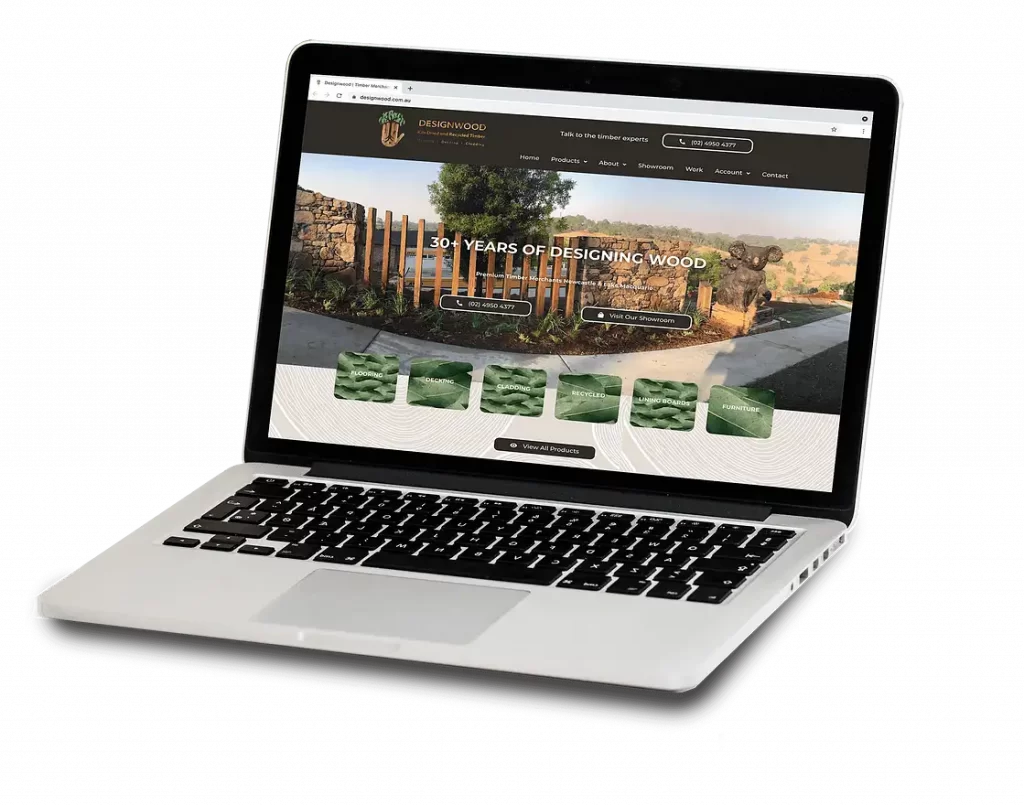Creating a website for your small business is like building the foundation of a brick-and-mortar store. It’s the first point of contact for potential customers and can make or break their first impression of your brand. In fact, numerous studies have proven that visitors form an opinion about a business within the first 0.5 seconds. With more and more customers shopping online, having attractive, functional, and easy-to-navigate websites has become essential. But the cost of web design poses a significant investment for small businesses.
The cost of getting a website designed can vary quite a bit, from just a few hundred dollars to tens of thousands. The total cost depends on a bunch of factors, like how complicated the project is and what kind of services you need. Knowing about these costs and factors can be really helpful for small business owners who want to make smart choices about investing in web design.
Cost of Web Design 2023
Single Page
A single-page website is a great choice for small businesses looking for an easy and cost-effective way to get online quickly.
A single-page website in Australia costs around $1,000 – $5,000 for basic design, hosting and domain name.
One-page sites are ideal for small businesses that don’t have too much content to include on their website. Examples could be personal trainers, hairdressers, tradespersons and startups.
Single Page sites typically include:
- Clear and simple layout
- Scrolling navigation bar
- A brief overview of the company or services
- Short sections for each service or product
Pros of a single-page website:
- Simplicity and ease of navigation
- Cost-effective
- Mobile-friendly
- Easy to maintain
Cons of a single-page website:
- Limited content
- Limited SEO
- Not suitable for complex businesses.
- Limited ability to promote different products or services

Multi-Page
Multi-page websites are the most popular option for small businesses in 2023. It can be used to showcase products and services, promote special offers, provide contact information, share news and press releases, display customer testimonials and more.
The average cost for a multi-page website for small businesses in Australia is typically between $1,500-$10,500 depending on the complexity of the website. It includes design & development costs, domain name registration, and hosting costs.
Some common features of a multi-page website for small businesses include:
- Multiple pages that cover different aspects of the business
- A homepage that serves as an overview of the business
- Dedicated pages for products or services
- Contact page with contact details and/or form
- A blog or news section for updating information
Pros of a multi-page website:
- Ability to present more detailed and comprehensive information
- Ability to promote different products and services
- More flexibility in terms of design and layout
- Ability to add more advanced features such as e-commerce or blog
Cons of a multi-page website:
- Can be more complex to navigate
- Typically more expensive to design and develop
- Need for more maintenance and updating.

E-commerce
An E-commerce website for small businesses allows business owners to quickly and easily set up an online storefront, allowing them to reach more customers than ever before. For small businesses in Australia, setting up a website is becoming increasingly popular as customers are turning to internet shopping.
The average cost for an e-commerce website is around $5,000 to $50,000. The jump in cost is due to the complexity of setting up a secure payment gateway, product pages, online shopping cart services and more.
Core features of an eCommerce website for small businesses include:
- Product catalogue and inventory management
- Shopping cart and checkout functionality
- Secure payment processing
- Order tracking and management
- Customer account management
- Product search and filtering
- Mobile responsive design
Pros of an eCommerce website:
- Ability to sell products and services online
- Convenience for customers to purchase products 24/7
- Increased reach and potential customer base
- Automated sales and inventory management
- Low overhead costs compared to physical stores
Cons of an eCommerce website:
- Requires investment in website development and maintenance
- Requires significant marketing efforts to drive traffic and sales
- Dependence on technology which may fail
- Need to comply with legal regulations and standards for online sales

Template Website
A majority of websites are built from website templates and pre-designed layouts. Template websites are a more affordable option for small businesses or individuals that want to establish an online presence. Predesigned templates are popular due to their cost-effectiveness, quick turnaround time, wide range of options, flexibility, and built-in functionality.
The template website is built with a platform like WordPress, Wix, Shopify or others. Pricing can vary enormously depending on the level of customisation required, such as the number of pages and different types of content. Typically template websites in Australia for small businesses can cost from $5,000 to $15,000.
Core features of a template website include:
- Customisable colour scheme and branding elements
- Built on a popular and flexible website platform
- Option to add or remove features and functionality as needed
- Mobile responsive design
- Integration with popular e-commerce and social media platforms
Pros of template website:
- Cost-effective
- Quick turnaround time
- A variety of options are available
- Flexible and Customisable
- Built-in functionality
- Support and updates
Cons of template website:
- Limited customisation depending on the platform and agency
- Some functionalities may not be built-in
- Need to have some technical knowledge to manage the website

Custom
Custom websites are great for businesses with unique requirements or need advanced functionality, such as large businesses, businesses that need to stand out, highly visual industries, or businesses that need a unique design.
Typically, custom websites will be the most expensive option, with prices ranging from $15,000 to hundreds of thousands of dollars. This is due to the higher level of customisation and flexibility in design.
A custom website will usually include:
- Customised visual design elements
- Unlimited functionality and features
- Highly customisable user experience (UX)
- Integration with existing systems or third-party software
Pros of a custom website:
- Unique design and layout
- Advanced functionality
- Scalability
- SEO-friendly
Cons of a custom website:
- More expensive
- Longer development time
- Higher maintenance and updating costs
- More technical expertise needed
DIY VS Web Design Consultant
With so many options for building a website, many businesses are tempted to tackle the building process themselves. However, while it may seem like an easy and cost-saving proposition, many pitfalls can come with DIY web design. When it comes to building a website for your business, it’s worth considering hiring a professional web designer.
First and foremost, a pro web designer brings expertise to the table. They have the know-how and experience to create a website that not only looks great but also effectively achieves your business goals. From attracting visitors to keeping them engaged and converting them into customers, a professional designer ensures that all the right elements are in place.
A well-designed website that is easy to navigate, modern, and contains accurate and relevant information will help to establish your business as a credible and trustworthy source. Moreover, if you rely on online sales or conversions, a poorly designed website can drive potential customers away.
On the other hand, trying to design a website in-house can actually be detrimental to your business. Not only is it often more time-consuming and costly, but your in-house team may not have the same level of expertise, resources, and experience as a professional design agency.
This can result in a website that is less effective or looks less professional, ultimately hurting your business. And not just that, but if you are not careful, it can also lead to increased costs to fix mistakes, loss of potential customers and time.
Elements of Web Design Pricing
Design and layout is one of the major elements that go into web design. It includes the cost of creating the overall visual appearance and user interface of the website. This is typically done by a web designer, who will work closely with the client to understand their needs and preferences, and to create a design that is visually appealing and easy to use.
Development is another important element that goes into web design. This includes the cost of coding and programming the website to make it functional. A web developer will take the design and layout created by the designer and convert it into a website that can be viewed on the internet. This process can include using templates or cloud services like WordPress, which can lower the development costs.
Content is another important element that goes into web design. This includes the cost of creating and optimising the text, images, and other forms of media that will be used on the website. This might include the cost of writing copy, sourcing images, and creating videos. High-quality content is essential for attracting and retaining visitors to your website, so it’s important to factor in the cost of creating and optimising this content.
Features and functionality are also important to consider when it comes to web design. This includes the cost of adding various features and functionalities to the website, such as e-commerce integration, contact forms, and social media integration. These features can add significantly to the cost of web design, so it’s important to consider which ones are essential for your business.
Maintenance and support are other elements that go into web design. This includes the cost of keeping the website updated, secure, and running smoothly. This can include regular software updates, backups, and monitoring for security issues. The cost of maintenance and support can vary depending on the level of service and the type of web design service you choose.
Cost of Web Design 2023 Australia
In conclusion, creating a website for your small business is an essential step in establishing a strong online presence. Understanding the different elements that go into web design pricing can help you budget accordingly and make informed decisions about what you can afford and what you need.
The average cost of web design can range anywhere from a few hundred dollars to tens of thousands, depending on the complexity and customisation of the project. Factors such as design and layout, development, content, features and functionality, maintenance and support, domain and hosting, and search engine optimisation, all play a role.
Finally, by understanding these elements and how they affect the cost of web design, you can ensure that you’re getting the best value for your investment and ensure the success of your online presence.

